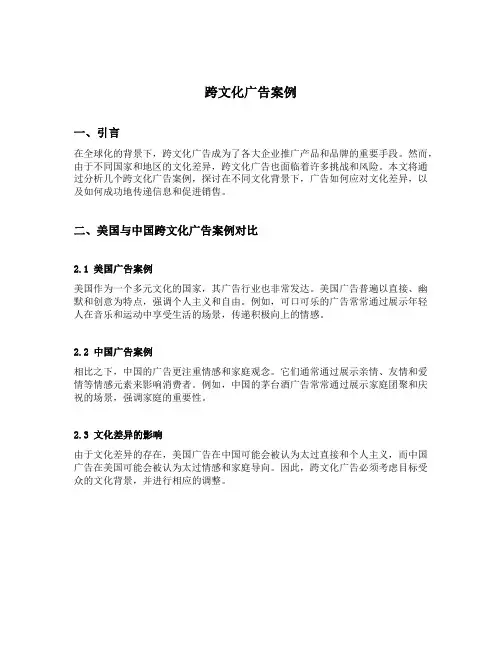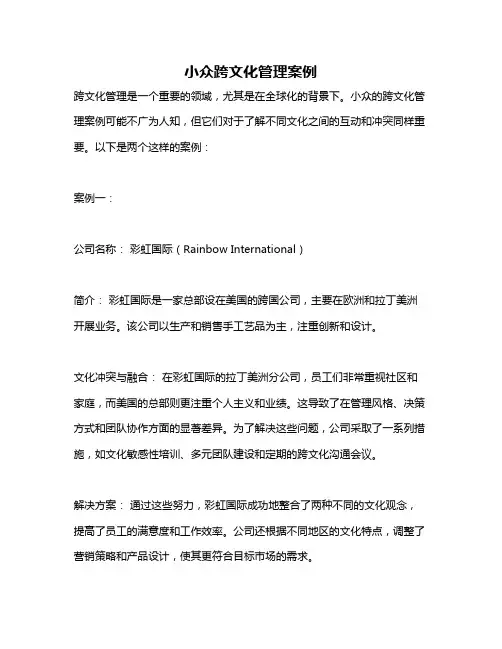美国商业跨文化交流
- 格式:doc
- 大小:67.00 KB
- 文档页数:10

国际商业和跨文化交流(International business and cross cultural) theincreaseininternationalbusinessandinforeigninvestmenthas createdaneedforexecutiveswithknowledgeofforeignlanguagesand skillsincross-culturalcommunication.americans,however,havenotbeen welltrainedineitherareaand,consequently,havenotenjoyedthesame levelofsuccessinnegotiationinaninternationalarenaashavetheir foreigncounterparts. negotiatingistheprocessofcommunicatingbackandforthforthepurpose ofreachinganagreement.itinvolvespersuasionandcompromise,butin ordertoparticipateineitherone,thenegotiatorsmustunderstandthe waysinwhichpeoplearepersuadedandhowcompromiseisreachedwithin thecultureofthenegotiation. inmanyinternationalbusinessnegotiationsabroad,americansareperceived aswealthyandimpersonal.itoftenappearstotheforeign negotiatorthattheamericanrepresentsalargemulti-million-dollar corporationthatcanaffordtopaythepricewithoutbargainingfurther. theamericannegotiator'srolebecomesthatofanimpersonalpurveyorof informationandcash. instudiesofamericannegotiatorsabroad,severaltraitshavebeen identifiedthatmayservetoconfirmthisstereotypicalperception,while underminingthenegotiator'sposition.twotraitsinparticularthatcausecross-culturalmisunderstandingaredirectnessandimpatienceonthepart oftheamericannegotiator.furthermore,americannegotiators ofteninsistonrealizingshort-termgoals.foreignnegotiators,onthe otherhand,mayvaluetherelationshipestablishedbetweennegotiatorsand maybewillingtoinvesttimeinitforlong-termbenefits.inorderto solidifytherelationship,theymayoptforindirectinteractions withoutregardforthetime involvedingettingtoknowtheothernegotiator.clearly,perceptionsanddifferencesinvaluesaffecttheoutcomesof negotiationsandthesuccessofnegotiators.foramericanstoplaya moreeffectiveroleininternationalbusinessnegotiations,theymustput forthmoreefforttoimprovecross-culturalunderstanding.际商业和跨文化交流英语作文译文:国际贸易和海外投资的增加产生了对具有外语知识和跨文化交流技巧的经理的需求。

跨国企业跨文化管理案例
嘿,大家知道吗?跨国企业的跨文化管理就像是一场刺激的冒险!让我给你们讲讲那些精彩的案例。
就拿麦当劳来说吧,它在全球各地都有门店。
在不同的国家和地区,他们面临着各种各样的文化差异。
比如在美国,大家喜欢大杯的可乐和巨无霸汉堡,自由随意地享受美食。
可是在日本呢,人们更注重精致和细节,麦当劳就得根据当地口味调整菜单和服务方式。
这就好比一个武林高手,在不同的江湖中都得有自己的独特招式才能立足,不是吗?
再看看可口可乐,它可是饮料界的巨头。
在不同文化中,可口可乐得根据当地的习俗和喜好来营销。
在中国,过年的时候推出特别的包装,充满喜庆;而在巴西,结合当地狂欢节的氛围来宣传。
这多像一个会七十二变的孙悟空啊,根据不同的情况变出最合适的模样!
还有星巴克,在不同国家的店铺装修和氛围都不一样。
在中国可能更强调休闲和舒适,在意大利就得面对当地深厚的咖啡文化挑战,得拿出真本事来赢得顾客的心。
就好像一场激烈的足球比赛,每个队都有自己的特色战术,谁能更好地适应变化,谁就能赢得胜利。
这些跨国企业就像勇敢的航海家,在跨文化的海洋中勇往直前。
它们得学会理解、尊重和融合各种文化,才能在全球市场上乘风破浪。
所以说啊,跨文化管理可不是一件容易的事儿,但那些做得好的企业真的太牛了!它们用智慧和策略打破了文化的壁垒,创造了一个又一个的商业奇迹。
这就是跨国企业跨文化管理的魅力所在,让人忍不住为它们拍手称赞!。

跨文化广告案例一、引言在全球化的背景下,跨文化广告成为了各大企业推广产品和品牌的重要手段。
然而,由于不同国家和地区的文化差异,跨文化广告也面临着许多挑战和风险。
本文将通过分析几个跨文化广告案例,探讨在不同文化背景下,广告如何应对文化差异,以及如何成功地传递信息和促进销售。
二、美国与中国跨文化广告案例对比2.1 美国广告案例美国作为一个多元文化的国家,其广告行业也非常发达。
美国广告普遍以直接、幽默和创意为特点,强调个人主义和自由。
例如,可口可乐的广告常常通过展示年轻人在音乐和运动中享受生活的场景,传递积极向上的情感。
2.2 中国广告案例相比之下,中国的广告更注重情感和家庭观念。
它们通常通过展示亲情、友情和爱情等情感元素来影响消费者。
例如,中国的茅台酒广告常常通过展示家庭团聚和庆祝的场景,强调家庭的重要性。
2.3 文化差异的影响由于文化差异的存在,美国广告在中国可能会被认为太过直接和个人主义,而中国广告在美国可能会被认为太过情感和家庭导向。
因此,跨文化广告必须考虑目标受众的文化背景,并进行相应的调整。
三、成功的跨文化广告案例分析3.1 麦当劳的“我就喜欢”广告麦当劳在中国推出的“我就喜欢”广告是一个成功的跨文化广告案例。
该广告通过展示中国人在麦当劳享受快乐时光的场景,强调与家人和朋友一起用餐的重要性。
这符合中国文化中强调亲情和社交的价值观,赢得了中国消费者的认可和喜爱。
3.2 宝洁的“爸爸去哪儿”广告宝洁在中国推出的“爸爸去哪儿”广告也是一个成功的跨文化广告案例。
该广告通过展示父亲和孩子之间的亲子互动,强调家庭的重要性和宝洁产品在家庭中的作用。
这符合中国文化中强调家庭观念和亲子关系的价值观,赢得了消费者的共鸣。
3.3 成功的因素总结以上两个案例的成功之处在于它们能够深入理解目标受众的文化背景,并运用相应的文化元素来传递信息。
同时,它们也在广告中展示了产品与目标受众的关联,使消费者能够产生共鸣并愿意购买产品。

小众跨文化管理案例跨文化管理是一个重要的领域,尤其是在全球化的背景下。
小众的跨文化管理案例可能不广为人知,但它们对于了解不同文化之间的互动和冲突同样重要。
以下是两个这样的案例:案例一:公司名称:彩虹国际(Rainbow International)简介:彩虹国际是一家总部设在美国的跨国公司,主要在欧洲和拉丁美洲开展业务。
该公司以生产和销售手工艺品为主,注重创新和设计。
文化冲突与融合:在彩虹国际的拉丁美洲分公司,员工们非常重视社区和家庭,而美国的总部则更注重个人主义和业绩。
这导致了在管理风格、决策方式和团队协作方面的显著差异。
为了解决这些问题,公司采取了一系列措施,如文化敏感性培训、多元团队建设和定期的跨文化沟通会议。
解决方案:通过这些努力,彩虹国际成功地整合了两种不同的文化观念,提高了员工的满意度和工作效率。
公司还根据不同地区的文化特点,调整了营销策略和产品设计,使其更符合目标市场的需求。
案例二:公司名称:心语翻译(Heartfelt Translation)简介:心语翻译是一家提供语言翻译服务的中国公司,其业务逐渐扩展到了国际市场。
文化冲突与融合:在心语翻译的国际化过程中,中西方在工作价值观、时间管理和人际关系处理等方面存在显著的差异。
例如,中国员工更注重和谐的人际关系和集体主义,而西方员工更强调个人责任和结果导向。
此外,不同文化对时间的管理也有不同的观念。
解决方案:心语翻译通过多种方式解决这些问题,包括提供跨文化培训、建立多元文化团队、调整工作流程以适应不同文化的时间观念等。
此外,公司还鼓励员工进行跨文化交流,分享彼此的文化背景和工作经验。
这两个案例都展示了在不同文化背景下,如何通过有效的跨文化管理来克服挑战并实现商业成功。

【精品】跨文化交际案例【案例一】中美商务谈判在中美商务谈判中,由于两国文化背景和价值观念的差异,经常会出现一些误解和沟通障碍。
例如,中国人在谈判中比较注重关系的建立和维护,而美国人则更加注重双方的利益和目标。
在谈判中,中国人可能会采取一些间接的方式来表达自己的意见和需求,而美国人则更加直接和坦率。
此外,在决策过程中,中国人可能会采取集体协商的方式,而美国人则更加注重个人能力和权威。
这些差异可能导致双方在沟通中产生误解和冲突,因此需要尊重彼此的文化和价值观念,采取适当的沟通方式,以建立长期稳定的商业合作关系。
【案例二】中美家庭教育的差异中美家庭教育的差异也是跨文化交际中一个比较典型的案例。
中国父母普遍注重孩子的学习成绩和各种才艺的培养,强调“严师出高徒”,严格管教孩子的学习和生活,而在美国,家长更加注重培养孩子的独立性和自主性,认为孩子应该有自己的兴趣爱好和选择权。
此外,在沟通和表达方面,中国家长往往比较含蓄和内敛,而美国家长则更加开放和直接。
在面对孩子的教育问题时,中国家长往往更加关注孩子的成绩和排名,而美国家长更加注重孩子的兴趣和天赋。
这些差异需要双方理解和尊重彼此的文化和教育观念,以达到有效的沟通和合作。
【案例三】国际会议国际会议是一种非常重要的跨文化交际形式,涉及各国代表团和与会者之间的交流和合作。
在会议中,不同国家和地区的代表团通常会带来不同的文化背景和价值观念,这可能会导致各种形式的冲突和分歧。
例如,在一些国际会议中,欧洲代表团往往强调民主和人权,而非洲代表团则更加关注经济发展和社会福利。
此外,不同国家和地区的代表团在会议中的角色和地位也可能存在差异,一些国家可能更加注重发言权和影响力,而另一些国家则可能更加注重参与和合作。
在这种情况下,跨文化交际的技巧和策略就显得尤为重要。
首先,需要尊重和理解不同国家和地区的文化背景和价值观念,避免因为文化差异而产生冲突和分歧。
其次,需要采取积极的态度和合适的方式与各国代表团进行交流和合作,寻求共识和妥协的方案。

美国跨文化沟通范文美国是一个多元文化的国家,因此跨文化沟通是非常重要的。
在跨文化沟通中,理解和尊重不同文化背景的差异是至关重要的,这有助于建立有效的关系和避免误解和冲突。
首先,在与美国人进行跨文化沟通时,了解他们的价值观和习俗是很重要的。
美国是一个个人主义的社会,强调个人的权利和自由。
在与美国人交流时,我们应该关注个人目标和自主性,并尊重他们的个人空间和时间概念。
其次,美国人是直接表达自己观点的,因此在沟通中应该坦率、直接并有逻辑。
透明和直接的沟通是美国文化的核心价值观之一,因此我们应该学会表达自己的观点,并听取对方的意见,避免过分含糊或间接。
此外,与美国人进行跨文化沟通时应注意避免使用个人称呼。
在美国,人们普遍使用名字或姓氏来称呼对方,而不是使用称谓或敬语。
因此,我们应该遵循这种用法,并在称呼他人时尽量使用他们的名字。
除了语言上的差异,文化中的非语言沟通也是跨文化沟通中的一个重要方面。
在美国,非语言行为和身体语言是常用的沟通方式。
握手、微笑和眼神接触等都被视为友好和尊重的方式。
当与美国人交流时,我们应该学会利用这些非语言信号来传达自己的意图和情感。
最后,我们还应该尊重美国的多元化和包容性。
美国是一个移民国家,有着各种各样的人口背景和文化。
在与美国人进行跨文化沟通时,我们应该尊重他们的身份和文化,并避免对他们的偏见或歧视。
尊重和接纳不同文化背景是构建有效和和谐关系的关键。
总之,在与美国人进行跨文化沟通时,了解和尊重美国文化的差异是非常重要的。
通过学习他们的价值观、习俗和沟通方式,我们可以建立更有效和理解的关系。
尊重差异、表达清晰和利用非语言沟通是成功的跨文化交流的关键。

解析中美跨文化商务交往中的时间观差异与影响跨文化交流与交往中的时间观念因文化传承的不同而存在差异,这种差异在中美两国的文化交流中尤其明显。
在商务交往中,时间观念的差异会给双方带来影响和挑战,本文将分析这些差异及其带来的影响,并提出一些解决方案。
中美时间观念的不同点中国文化中的时间观念强调“王道”,即万事万物应有一个先后顺序和优先级,而且要讲究时机,讲究知己知彼,百战百胜。
这种时间观念表现在商务交往中,比如重视熟人介绍,会在第一次见面时询问彼此家庭、工作和出生地等个人信息,以建立起相互信任和尊重的关系。
反之,美国文化中的时间观念更偏向于“宽松”,强调时间的效率和利用率,在商务交往中,更注重规定的时间表,对于工作计划和时间表的执行也会更加严格。
美国人往往会注重直接表达自己的立场和意见,这种直接表达的行为在中美商务交往中很容易引起不必要的误解和冲突。
时间观念差异带来的影响时间观念的差异在中美商务交往中会产生一些不同的影响:1. 沟通效率不高中美的时间观念差异会影响到沟通的效率。
中方在商业交往中非常重视熟人关系,通常需要花费大量的时间来建立和维护关系,而美方则更注重时间的利用效率,更喜欢直接表达自己的需求和意愿。
这样一来,双方在商务交往中的沟通效率就会受到影响,甚至有可能发生交流障碍和误解。
2. 时间观念的冲突中美的时间观念在商务交往中也会产生冲突。
针对任务和时间的意识不同,可能会出现在预订订单时间表时难以达成一致的情况,时间表的执行也可能会因此产生不同程度的延迟。
美方更加注重严格按照时间执行计划,但在中方文化中,拖延和调整时间表的现象更加普遍,这也会给商业活动带来不确定性,增加交易风险。
3. 交际策略与谈判技巧的不同不同国家、不同文化背景的人在处理交际策略和谈判技巧方面存在差异,从而影响了商业沟通的效率。
在时间观念方面,中方在处理谈判时更加注重“以人为本”,在保持和谐关系的前提下谈判,而美国人会更多地考虑清晰的目标、与时间、成本和质量等因素的平衡。

关于跨文化交流,跨文化市场才是第一的真正的首要的范本。
考虑到古罗马帝国的市民,他们是第一个诞生商店的地球文明。
商人们通过在商店的上面树立旗帜来展示他们商品货物的图片来解决跨文化市场的困扰。
这种做法不仅能为罗马帝国中未受过教育的市民服务还能帮助罗马商人们获得被他们用武力征服的殖民地的商业信息。
回顾过去,我们会发现两千多年前的亚里士多德曾明确说过:“有效劝服基本的信念仍可以把他应用到今天的买卖商品上然而在古代的雅典可能会引起一场大的争论”。
很明显的可以看出,交流是现代市场的根基。
毋庸置疑,全球化市场的时代已经到来。
每年超过4万件的商品货物进入国际市场,其中超过一半是来自美国。
这里面85%的商品都不合格。
通往国际化市场成功的道路是建立在失败的市场垃圾碎片和广泛的广告活动之上的。
他们中的大多数之所以会失败,是因为跨文化交流被曲解了。
在跨文化市场里,如果你想把低劣的语言举止降低到最小,那么就不假定任何事情。
几乎我们都听说过关于美国通用汽车公司,他们尽力想把他们的雪佛兰牌汽车销往拉美国家。
但是雪佛兰在说西班牙语的拉美国家按字面意思是不能行走。
当公司发现汽车买不出去的原因时,他们就把车重新命名,然后销往这些国家。
福特汽车公司,美国又一个汽车界的领头羊,也有类似的问题。
他们的pinto 牌汽车在当地也没有达到预期的销售,原因时他们的汽车其意思在当地为男性生殖器。
最终福特公司把所有的名牌汽车重新命名为corcel,其意思为骏马。
伊莱克斯,一个日用电器制造者,其在英国获得了很大的成功。
不幸的是,他们的广告招牌的意思在美国和英国大不相同。
在美国,suck的意思是多虱子的。
英国的牙膏生产商在法国制造出来了一种牙膏叫cue。
它被人们所耻笑。
因为它的名字使人想起了臭名昭著的色情杂志——Cue。
但是市场中的文化意识更多于细心的翻译。
每一文化都有其微妙之处,当然也有其鲜明的禁忌。
尽管大多数的人不能列出他们自己文化的规则,但是他们很明白什么时候这些禁忌被触碰了。

跨文化谈判案例在今天全球化的背景下,跨文化谈判已经成为商业谈判中不可或缺的一部分。
不同国家、不同文化背景的人们在商业谈判中往往会因为文化差异而产生误解和冲突。
因此,跨文化谈判的成功与否,不仅取决于双方的商业能力,更取决于双方是否能够理解对方的文化,并在谈判中进行有效地沟通和协商。
以下是一个关于跨文化谈判的案例,通过这个案例我们可以看到在跨文化谈判中应该如何应对和解决文化差异所带来的挑战。
案例,一家中国公司与一家美国公司进行合作谈判。
一家中国公司和一家美国公司打算进行合作,双方在谈判中出现了一些文化差异。
中国公司的代表认为在商业谈判中应该以建立个人关系为主,先建立起友好的关系,然后再进行商业谈判。
而美国公司的代表则认为在商业谈判中应该以商业利益为主,先确定合作的商业条款,然后再考虑个人关系。
在这种情况下,中国公司的代表可能会觉得美国公司的代表过于冷漠和直接,而美国公司的代表可能会觉得中国公司的代表过于拖泥带水和不够专业。
这种文化差异可能会导致双方在谈判中产生误解和冲突,从而影响到合作的达成。
针对这种情况,双方可以采取以下措施来解决文化差异所带来的挑战:首先,双方应该尊重对方的文化差异,不要将自己的文化标准强加于对方。
中国公司的代表可以适当调整自己的谈判方式,更加注重商业利益和专业性,而美国公司的代表也可以适当调整自己的谈判方式,更加注重个人关系和人情味。
其次,双方可以通过交流和沟通来增进对方的了解。
中国公司的代表可以向美国公司的代表介绍中国的商业文化和商业习惯,让对方更加了解中国的商业环境和商业规则;而美国公司的代表也可以向中国公司的代表介绍美国的商业文化和商业习惯,让对方更加了解美国的商业环境和商业规则。
最后,双方可以寻求第三方的帮助来解决文化差异所带来的问题。
可以邀请一些具有跨文化谈判经验的专家或者顾问参与到谈判中,他们可以帮助双方更好地理解对方的文化差异,从而更好地进行合作谈判。
通过以上措施的采取,双方可以更好地应对和解决文化差异所带来的挑战,从而更好地进行合作谈判,达成合作协议。

跨文化商务交流迄今为止,背景不同的人给文化下了很多定义,但一般意义上,文化指知识、信仰、艺术、法律、伦理、风俗、习惯等综合,这种综合决定了生活在特定环境中的人的价值观念和心理素质。
它具有约束力,影响着具有同样文化背景的人的行为。
不同国家有自己独特的文化、历史、习俗等等。
国际商务谈判是跨国界发生的活动,这就意味着,了解各国不同的文化环境以及考虑到商业活动中的文化差异在国际商务谈判中是非常重要的。
如果想取得同外方谈判的成功,跨越文化的局限是一件艰巨而又至关重要的任务。
因为不管是什么技术、不管某个产品会带来什么样的利益,所有的商业交易都是由人来做的。
对文化差异的理解几乎影响谈判过程的各个方面,小到说话的艺术,大到决策过程,对其缺乏认识和了解,会使谈判复杂化,甚至会阻碍谈判。
例如,美国人吃完手抓的食品后把手放在嘴里吮吸,中国人很不习惯;而中国人吃饭时,若不分餐美国人则难以下咽。
所以在国际商务谈判中,应注意合作对手的文化,是谈判与合作成败的一个关键所在。
在国际商务谈判中,哪些具体的文化因素在起着作用呢?下文中提到的一些因素一般被认为对国际商务谈判具有重要的影响。
一、语言和交流人们的交流方式,包括语言交流和非语言交流,直接影响着国际商务谈判。
语言是谈判力量的一大源泉,几乎在各种谈判中,无论大小,重要或是不重要,语言——包括口头语言和书面语言,都将成为是否达到谈判目的的决定因素。
一般人在相同文化背景下讲话的内容尚有误差,可以想象,当一个人讲第二种语言时,误差肯定会更大,这是因为语言决定着文化,不同的语言有其独特的建构信息的方式。
操双语者要在语言之间转换,在转换过程中,他们要调整自己的观念和思维过程,以适应所使用的语言。
所以跨文化谈判总是面临着语言障碍,为了确保沟通的顺利进行,一般商务英语谈判要求使用翻译,一个好的翻译不但熟练运用两种语言,还应具备相应的专业技术知识。
根据传统,日本人认为直视另一个人的眼睛是不礼貌而且危险的。

国际商务中的跨文化交流技巧在全球化的今天,跨国企业越来越多,国际商务的交流也变得更加频繁和复杂。
而跨文化交流技巧的掌握对于一个企业来说是非常重要的。
一个企业如果能掌握跨文化交流技巧,就可以更好地应对国际商务中的各种挑战,提高企业的竞争力。
本文将介绍在国际商务中跨文化交流的一些技巧。
一、了解对方文化首先,在进行跨文化交流前需要了解对方的文化背景。
不同的文化背景产生了不同的言行举止和习惯,在进行交流时需要有所注意。
例如,在中国商务场合,称呼对方“先生”、“女士”是非常普遍的,而在美国、英国等国家则更常用称呼对方的名字。
此外,饮食习惯也是一个需要注意的方面,不同的国家有不同的饮食文化,如果在商务餐厅中出现了一些误会或尴尬的场面,也许会影响到商务谈判的进行。
二、尊重对方文化除了了解对方文化,还需要尊重对方的文化。
在跨文化交流中,尊重对方文化是非常重要的一个方面。
尊重对方文化可以帮助我们获得对方的信任和尊重,从而更好地展开商务谈判。
例如,在某些穆斯林国家,女性的权利和地位受到一定限制,那么我们在和穆斯林国家企业进行交流时就需要尊重他们的习惯和信仰,避免言语或行动上的冒犯。
三、语言应用得当语言是交流中非常重要的一个方面,不同的语言能够传达不同的信息。
在跨文化交流中,语言应用得当非常关键。
如果不能做到言之有物、善于表达,沟通就会难以顺利展开。
同时,需要注意语言的口吃、流利、得体、礼貌等方面。
在语言翻译方面,一定要确保所聘用的译员翻译的准确无误,并且能够有所体现语言的特色和文化背景。
四、重视礼仪与礼节在跨文化交流中,礼仪与礼节也是非常重要的方面。
需要重视的不仅仅是正式的商务交流,还包括一些其他的场合,例如招待客人、走访企业、旅游等等。
在不同的国家和地区,人们的礼仪和礼节有所不同,在进行跨文化交流时需要做到心中有数,尊重对方的礼仪和礼节,这样才能展现出尊重和礼貌的态度,并获得对方的尊重和信任。
例如,在一些穆斯林国家,穆斯林需要在清真寺里拜拜,其他的宗教或者信仰不能进入,我们要做到尊重他们的习惯和信仰,不要去质疑他们的信仰到底有多少真相存在。
从跨文化交际角度以案例分析中美商务谈判的差异一、本文概述随着全球化的深入推进,跨文化交际在商业活动中变得越来越重要,特别是在商务谈判中。
中美两国,作为世界上最大的经济体之一,其商务谈判风格和策略的差异对双方的经济合作有着深远影响。
本文旨在从跨文化交际的角度出发,以案例分析的形式探讨中美商务谈判中存在的差异,以期帮助双方更好地理解对方的文化背景,优化谈判策略,促进更有效的商业合作。
本文将首先概述中美商务谈判的基本风格和特点,然后从语言、非语言行为、价值观、思维方式等方面分析双方谈判风格的差异。
接着,通过具体案例,详细剖析这些差异在商务谈判中的具体表现和影响。
本文将提出在跨文化交际背景下,如何调整谈判策略,克服文化差异带来的挑战,以实现双方共赢的建议。
通过本文的研究,我们期望能够增进中美两国在商务谈判中的相互理解和信任,推动双方在商业领域的合作更加深入和广泛。
也希望本文的研究能对其他跨文化商务谈判提供一定的借鉴和启示。
二、中美商务谈判的文化背景文化差异是影响中美商务谈判的重要因素之一。
下面将从跨文化交际的角度,分析中美商务谈判在文化背景方面的差异。
价值观差异:中国和美国有着截然不同的价值观,这些差异反映在谈判中表现为对风险、责任和承诺的不同看法。
中国强调和谐、合作和相互尊重,而美国则更注重个人主义、竞争和自我实现。
这种差异导致在中美商务谈判中,双方对问题的理解、目标和解决方案等方面存在差异。
商业环境差异:中国的市场经济起步较晚,但发展迅速,形成了独特的商业文化和市场规则。
相比之下,美国的商业环境已经非常成熟,具有完善的市场机制和法律体系。
这种差异导致中美在商业决策、时间观念和诚信要求等方面的不同。
沟通方式差异:由于文化背景的差异,中美在沟通方式和语言习惯上也存在很大差别。
在中国,人们通常注重情感交流和间接表达,而在美国,人们则更倾向于直接表达情感和观点。
这种差异可能导致误解和不愉快的中美商务谈判经历。
跨文化交流:中美商务谈判中的文化差异与解决方案引言当今全球化时代,跨文化交流已成为商务谈判中不可忽视的重要因素。
而在中美商务谈判中,由于中美两国文化的差异,往往会导致双方产生误解和冲突,影响到谈判的进展和结果。
因此,了解并解决中美商务谈判中的文化差异是非常重要的。
那么,中美商务谈判中的文化差异具体有哪些?又该如何解决这些差异呢?本文将从沟通方式、时间观念、礼仪规范等多个方面进行探讨,为读者提供有效的解决方案。
沟通方式的差异与解决方案直接沟通与间接沟通的差异在中美商务谈判中最重要的差异之一就是沟通方式的不同。
中国人通常倾向于使用间接沟通的方式,而美国人则更喜欢直接沟通。
这可能会导致误解和争议。
美国商务人士在表达观点时,常常直接而直白。
他们认为直接表达更能促进问题解决和效率提升。
然而,中国人更注重面子和关系,更倾向于更加含蓄和委婉的沟通方式。
解决方案:融合直接与间接沟通方式为了解决中美商务谈判中的沟通差异,双方需要相互尊重并试图融合各自的沟通方式。
中方需要更加直接并清晰地表达自己的观点,而美方则需要更加注重对话过程中的委婉和尊重他人的表达方式。
此外,双方可以通过提供明确的意见反馈、积极倾听对方的观点以及主动提供解决问题的建议等方式来改善沟通效果。
这样可以确保双方在商务谈判中更好地理解对方,减少误解和冲突的可能性。
时间观念的差异与解决方案时间观念的不同中美商务谈判中时间观念的差异也是一个重要的文化差异。
美国人通常注重时间的效率和准时性,他们遵守时间表并且珍视时间的价值。
相比之下,中国人更加注重人际关系,更容易接受弹性和不那么精确的时间安排。
这种差异可能导致误会和不协调。
比如,当美方参与商务谈判的人提前到达会议室并期望按计划开始时,中国人可能会迟到一段时间,这对美方来说可能会被视为不尊重和不专业。
解决方案:尊重对方的时间观念并寻求平衡为了解决时间观念上的差异,双方应该相互尊重彼此的时间观念,并寻求共同的平衡点。
专业的跨文化交际案例跨文化交际是指在不同文化背景下,通过言语、行为、符号等交流方式进行沟通和交流。
在全球化的背景下,跨文化交际能力对于个人的发展和组织的成功都至关重要。
本文将通过探讨两个专业领域中的跨文化交际案例来说明其重要性和应用价值。
案例一:国际商务谈判在国际商务谈判中,来自不同文化背景的商业代表需要进行有效的交流和合作,以达成双方的商业目标。
在这个案例中,我们以中美商务谈判为例进行分析。
首先,双方代表应该了解对方文化的基本特点,包括礼仪、信仰、价值观等。
比如,在中国文化中,注重面子、人情关系和家庭价值观是非常重要的,因此,美国代表在与中国代表交流时需要注意这些方面,尊重对方的价值观念并避免冒犯。
而在美国文化中,效率、个人主义和直接表达观点是更为重要的,中国代表在与美国代表交流时需要注意这些方面,尽量简洁直接地表达自己的意思。
其次,语言和非语言交流也是关键因素。
在跨文化交际中,语言的语法、词汇和语调都可能引起误解或歧义。
因此,双方代表需要学习对方的语言并尽量准确表达自己的意思。
此外,非语言交流也是重要的,包括肢体语言、面部表情和眼神交流等。
双方代表需要学习对方的非语言信号并适应对方的文化习惯。
最后,文化敏感性和适应性是跨文化交际的关键能力。
双方代表应该具备对文化差异的敏感性和包容性,能够尊重和理解对方的文化,积极适应对方的习惯和方式。
在解决问题和处理冲突时,双方代表应该以合作的态度出发,共同寻求解决方案。
案例二:国际教育交流国际教育交流是指不同国家的学生和教育工作者之间的交流与合作。
在这个案例中,我们以中国留学生在美国大学的学习经历为例进行讨论。
首先,语言能力对于留学生的学习和交流至关重要。
留学生需要具备足够的英语能力,以便与教师和同学进行有效的交流和学术表达。
此外,留学生还需要学习和理解美国大学的学术规范和要求,在论文写作、演讲和参与课堂讨论时能够适应并符合美国学术界的要求。
其次,文化适应能力也是留学生必备的技能。
从跨文化视角分析中美商务谈判风格差异一、本文概述在全球化的今天,商务谈判已成为国际交流与合作的重要桥梁。
中美两国,作为世界上最大的经济体之一,其商务谈判风格差异显著,对于理解和适应这种差异,无论是在学术界还是在实务界,都具有重要意义。
本文旨在从跨文化的视角,深入剖析中美商务谈判风格的差异,以期帮助谈判者提高跨文化沟通能力,优化谈判策略,从而实现更有效的国际商业合作。
本文首先将对中美商务谈判风格的基本特征进行概述,包括各自的文化背景、谈判方式、决策过程等。
接着,将详细分析这两种风格在谈判准备、谈判过程、谈判结果等方面的具体差异,并探讨这些差异背后的文化因素。
在此基础上,本文还将提出一些实用的跨文化谈判技巧和策略,以帮助谈判者更好地应对中美商务谈判中的挑战。
通过本文的研究,我们期望能够增进对中美商务谈判风格差异的理解,提高谈判者在跨文化谈判中的应变能力和谈判效果,推动中美乃至全球的商业合作向更深层次发展。
二、中美商务谈判风格差异分析文化背景不同:中国和美国有着截然不同的文化背景,这种差异不仅体现在语言上,也渗透到商务谈判的每一个细节。
在中国,人们注重和谐、合作与面子;而在美国,人们强调个人主义、竞争和自我实现。
因此,在谈判中,中国人倾向于寻求共赢的合作方式,而美国人则更加强调各自利益和优势。
沟通方式差异:中美两国在沟通方式上也存在很大差异。
中国人在谈判过程中通常采取含蓄、委婉的方式表达自己的观点和建议,注重倾听对方的意见和反馈;而美国人则更加直接、坦率地表达自己的想法和需求,不太在意对方的感受。
这种沟通方式的差异导致在中美商务谈判中可能会出现误解和冲突的风险。
决策过程差异:中美两国在决策过程中也存在很大的差异。
在中国,决策通常是集体讨论的结果,强调团队合作和协商;而在美国,决策往往由个人或一小部分人做出,注重权力和控制的分配。
这种决策过程的差异可能导致双方在某些重要问题上的分歧和争议。
时间观念差异:中美两国的时间观念也存在很大差异。
跨文化场合交流成功案例案例一:跨国公司的跨文化合作一个以美国为总部的跨国公司在与一家以日本为总部的公司进行合作时,遇到了跨文化交流的挑战。
为了确保交流的成功,双方决定派出代表团进行面对面的会谈和讨论。
在会议前,代表团进行了充分的准备,包括研究了对方国家的商业礼仪和文化习俗。
美国代表团了解到日本文化注重尊重和细节,因此他们在交流时也非常注重对方的意见和感受。
在会议期间,双方代表团遵循了一些跨文化交流的成功原则。
他们尊重对方的文化习俗,包括在招待晚宴上享用日本传统美食和喝杯热茶。
他们避免直接争论和冲突,而是采取了温和的沟通方式。
他们通过提问和分享信息,以理性和逻辑的方式达成共识。
代表团对语言和表达方式的差异也进行了理解和尊重。
最终,这两家公司达成了成功的合作协议。
他们通过跨文化交流增进了相互之间的理解和信任,解决了合作中的问题,并建立了长期的商业伙伴关系。
案例二:跨文化婚姻的交流和理解李明是一个中国人,他在旅行中遇到了来自瑞典的安妮。
尽管他们来自不同的文化背景,但他们相互吸引,开始了一段跨文化的恋情。
为了确保他们的关系顺利发展,李明和安妮努力学习彼此的文化和语言。
他们互相教对方他们的母语,并详细了解彼此的家庭和传统。
他们也努力理解并尊重对方的价值观和生活方式。
当他们决定结婚时,面临了更多的跨文化挑战。
他们的家庭和朋友来自不同的文化,他们需要找到一种平衡,以便相互之间能够理解和接纳。
为了解决这些挑战,李明和安妮采取了一些措施。
他们安排了一场婚礼,融合了中式和西式的元素,以向两个家庭展示彼此的文化。
他们鼓励父母和家人进行跨文化交流和了解。
他们组织了一些家庭聚会和活动,以促进家庭成员之间的交流和互动。
通过这样的努力,李明和安妮成功实现了跨文化婚姻的交流和理解。
他们的家庭和朋友之间的关系逐渐变得融洽,他们也在相互尊重和支持中建立了稳固的婚姻基础。
1.5.1跨文化交际学在美国跨文化交际学之所以诞生于美国,是和当时的国际国内背景分不开的。
首先,因种族数量多、分布范围广、流动性大,美国又被称为“大熔炉”。
此外,美国在国际舞台上也扮演着非常重要的角色,国际交往日益频繁,跨文化冲突也时有发生。
也就是说,美国人不管在国内还是在国外,跨文化交际愈来愈频繁。
为了适应这种形势,一些美国有识之士意识到,要使美国人在跨文化交际中获得成功,就有必要开展跨文化交际研究。
下面,我们将简要介绍该学科产生的背景。
1.5.1.1 学科产生的背景首先,从国际背景来看,其根本原因是在于随着科技发展、世界经济全球化、广泛的移民潮以及多元文化主义的发展,邦国概念日益模糊,整个世界成为一个越来越相互依赖的“地球村”,来自不同文化背景的人们之间的交际越来越频繁,跨文化冲突也时有发生。
比如,曾有一批美国和平队队员前往菲律宾,两年后,4人辞职,26人被送回国,据分析是因为无法忍受文化隔阂造成的心理负担(胡文仲,1985:45)。
其次从国内背景来看,为了帮助训练美国人在国外能更有效地从事国际交往,帮助外国留学生适应美国的生活和学习环境,处理好各种族和各民族之间的关系,跨文化交际学这门学科就应孕而生。
总的说来,面对全新的国际形势,美国政府和一些有识之士认识到,研究跨文化交际活动,让美国的多元社会会更加和谐地发展,让美国人能够与其他文化的人更好地进行交往,是美国实现其雄心抱负的前提条件。
1.5.1.2发展历程根据跨文化交际学研究的内容来看,美国的跨文化交际学研究经历了四个阶段:草创期(1959年之前),基础期(1960-1969年),巩固期(1970-1979年)以及开花期(1980至今)(陈国明,2009:6-9)。
1)萌芽阶段(或草创期):20世纪50年代是跨文化交际研究的萌芽阶段。
1959年美国文化人类学家Edward T. Hall出版的这个The Silent Language首次使用了intercultural communication概念,标志着跨文化交际学的诞生。
Lesson Three·Cross-Cultural Communication in US Business·美国商业跨文化交流Part I ObjectivesPart II The How-TosIdentify the Differences :Six Fundamental Patterns of Cultural Differences了解不同:中西文化差异的六种基本模式1.Different Communication Styles 不同的交流风格The way people communicate varies widely between, and even within, cultures. One aspect of communication style is language usage. Across cultures, some words and phrases are used in different ways. For example, even in countries that share the English language, the meaning of "yes" varies from "maybe, I'll consider it" to "definitely so," with many shades in between.Another major aspect of communication style is the degree of importance given to non-verbal communication. Non-verbal communication includes not only facial expressions and gestures; it also involves seating arrangements, personal distance, and sense of time. In addition, different norms regarding the appropriate degree of assertiveness in communicating can add to cultural misunderstandings. For instance, some white Americans typically consider raised voices to be a sign that a fight has begun, while some Asian, African, Jewish and Italian Americans often feel that an increase in volume is a sign of an exciting conversation among friends. Thus, some white Americans mayreact with greater alarm to a loud discussion than would members of some American ethnic or non-white racial groups.2.Different Attitudes Toward Conflict 对待冲突的不同看法Some cultures view conflict as a positive thing, while others view it as something to be avoided. In the U.S., conflict is not usually desirable; but people often are encouraged to deal directly with conflicts that do arise. In fact, face-to-face meetings customarily are recommended as the way to work through whatever problems exist. In contrast, in many Eastern countries, open conflict is experienced as embarrassing or demeaning; as a rule, differences are best worked out quietly. A written exchange might be the favored means to address the conflict.3.Different Approaches to Completing Tasks 对待完成任务的不同方法From culture to culture, there are different ways that people move toward completing tasks. Some reasons include different access to resources, different judgments of the rewards associated with task completion, different notions of time, and varied ideas about how relationship-building andtask-oriented work should go together.When it comes to working together effectively on a task, cultures differ with respect to the importance placed on establishing relationships early on in the collaboration. A case in point, Asian and Hispanic cultures tend to attach more value to developing relationships at the beginning of a shared project and more emphasis on task completion toward the end as compared with Americans. Americans tend to focus immediately on the task at hand, and let relationships develop as they work on the task. This does not mean that people from any one of these cultural backgrounds are more or less committed to accomplishing the task, or value relationships more or less; it means they may pursue them differently.4.Different Decision-Making Styles 不同的决定风格The roles individuals play in decision-making vary widely from culture to culture. For example, in the U.S., decisions are frequently delegated -- that is, an official assigns responsibility for a particular matter to a subordinate. Inmany Southern European and Latin American countries, there is a strong value placed on holding decision-making responsibilities oneself. When decisions are made by groups of people, majority rule is a common approach in the U.S.; in Asia consensus is the preferred mode. Be aware that individuals' expectations about their own roles in shaping a decision may be influenced by their cultural frame of reference.5.Different Attitudes Toward Disclosure 对待披露/曝光的不同态度In some cultures, it is not appropriate to be frank about emotions, about the reasons behind a conflict or a misunderstanding, or about personal information. Keep this in mind when you are in a dialogue or when you are working with others. When you are dealing with a conflict, be mindful that people may differ in what they feel comfortable revealing. Questions that may seem natural to you -- What was the conflict about? What was your role in the conflict? What was the sequence of events? -- may seem intrusive to others. The variation among cultures in attitudes toward disclosure is also something to consider before you conclude that you have an accurate reading of the views, experiences, and goals of the people with whom you are working.6.Different Approaches to Knowing 对待事物认知的不同方式Notable differences occur among cultural groups when it comes to epistemologies -- that is, the ways people come to know things. Western cultures tend to consider information acquired through cognitive means, such as counting and measuring, more valid than other ways of coming to know things. Compare that to African cultures' preference for affective ways of knowing, including symbolic imagery and rhythm. Asian cultures' epistemologies tend to emphasize the validity of knowledge gained through striving toward transcendence. Recent popular works demonstrate that our own society is paying more attention to previously overlooked ways of knowing.You can see how different approaches to knowing could affect ways of analyzing a community problem or finding ways to resolve it. Some members of your group may want to do library research to understand a shared problem better and identify possible solutions. Others may prefer to visit places andpeople who have experienced challenges like the ones you are facing, and touch, taste and listen to what has worked elsewhere.Part III Let’s Talk BusinessWhat lies in “Corporate Culture”?Many articles and books have been written in recent years about culture in organizations, usually referred to as "Corporate Culture." The dictionary defines culture as "the act of developing intellectual and moral faculties, especially through education." This writing will use a slightly different definition of culture: "the moral, social, and behavioral norms of an organization based on the beliefs, attitudes, and priorities of its members." The terms "advanced culture" or "primitive culture" could apply to the first definition, but not the latter.Every organization has its own unique culture or value set. Most organizations don't consciously try to create a certain culture. The culture of the organization is typically created unconsciously, based on the values of the top management or the founders of an organization.Hewlett-Packard is a company that has, for a long time, been conscious of its culture (The HP Way) and has worked hard to maintain it over the years. Hewlett-Packard's corporate culture is based on 1) respect for others, 2) a sense of community, and 3) plain hard work (Fortune Magazine, May 15, 1995). It has been developed and maintained through extensive training of managers and employees. HP's growth and success over the years has been due in large part to its culture.Another successful company that expends a lot of energy in maintaining its workplace culture is Southwest Airlines. Southwest is the only major airline in the U.S. that has been profitable in each of the last five years. It also has a good reputation as an employer. In an article written in the ACA (American Compensation Association) Journal, Winter 1995 issue, Herb Kelleher, Southwest's CEO, indicated how Southwest maintained its culture:"Well, first of all, it starts with hiring. We are zealous about hiring. We are looking for a particular type of person, regardless of which job category it is. We are looking for attitudes that are positive and for people who can lendthemselves to causes. We want folks who have a good sense of humor and people who are interested in performing as a team and take joy in team results instead of individual accomplishments."If you start with the type of person you want to hire, presumably you can build a work force that is prepared for the culture you desire..."Another important thing is to spend a lot of time with your people and to communicate with them in a variety of ways. And a large part of it is demeanor. Sometimes we tend to lose sight of the fact that demeanor - the way you appear and the way you act - is a form of communication. We want our people to feel fulfilled and to be happy, and we want our management to radiate the demeanor that we are proud of our people, we are interested in them as individuals and we are interested in them outside the work force, including the good and bad things that happen to them as individuals."In both of these examples, the top management of the companies were vigilant about maintaining their cultures. The behavior rules and boundaries are relatively clear and communicated often. However, this is not typical. I believe most organizations operate with a diversity of cultures. This is especially true considering the increasing worldwide mobility of people and cultures and values.There have been some recent models created to attempt to study and classify cultural diversity. One model, the Hofstede Cultural Orientation Model, classifies cultures based on where they fall on five continuums.1. Individual vs. Collective OrientationThe level at which behavior is appropriately regulated2. Power-Distance OrientationThe extent to which less powerful parties accept the existing distribution of power and the degree to which adherence to formal channels is maintained.3. Uncertainty-Avoidance OrientationThe degree to which employees are threatened by ambiguity, and the relative importance to employees of rules, long-term employment and steady progression through well defined career ladders.4. Dominant-Values OrientationThe nature of the dominant values - e.g., assertiveness, monetary focus, well-defined gender roles, formal structure - vs. concern for others, focus on quality of relationships and job satisfaction, and flexibility5. Short-Term vs. Long-Term OrientationThe time frame used: short-term (involving more inclination toward consumption, saving face by keeping up) vs. long-term (involving preserving status-based relationships, thrift, deferred gratifications).There's some debate over whether companies should design their personnel policies and reward systems around cultural values. Currently companies tend not to, because of the concern about stereotyping certain cultures.A popular trend is for companies to "reengineer" themselves, which involves an attempt to change their culture, usually to a team orientation. As reported in the ACA News (September 1995), studies indicate that the following are necessary for a company to change to a "team culture:"·Common and consistent goals·Organizational commitment·Role clarity among team members·Team leadership·Mutual accountability with the team·Complementary knowledge and skills·Reinforcement of required behavioral competencies·Power (real and perceived)·Shared rewardsThe importance of corporate culture is growing as the result of several recent developments. Companies are encouraging employees to be more responsible and act and think like owners. In exchange for more flexible work schedules, employees are expected to always be "on-call." With the demise of more traditional communities (e.g. neighborhoods, etc.), companies are filling employees' need to belong to a community. At the same time companies are encouraging teamwork and the formation of teams.Therefore, organizational leaders shouldn't ignore corporate culture. Rather, it should be addressed in the organization's mission, vision, and goal statements, and emphasized in company sponsored training and company communication. The statements should include the following:·To be financially successful, etc. (employees want to belong to a successful organization)·To be accepting of cultural (ethnic) diversity·To encourage employees to "have a life" outside the company (provide sufficient paid time-off benefits and encourage employees to take the time)Part IIII Exercises and Discussions² Tell your fellow students about the corporate culture of the company that you work in. What do you think of it? What are some of the most unique characteristics of it? What have been done by your company to maintain such culture?² According to the article in Part Two and your business experience, give examples on cultural differences between Chinese business people and Western business people. Why do we consider some of our approaches common?² DECODING BODY LANGUAGE- The four basic modes of body language in business破解肢体语言–西方商业肢体语言得四种基本模式Knowing how to read body language is a useful communication skill. So is knowing how to use it. There are two basic groups of body language postures: OPEN/CLOSED and FORWARD/BACKOPEN/CLOSED is the most obvious. People with arms folded and legs crossed and bodies turned away are signaling that they are rejecting messages. People showing open hands, fully facing you and both feet planted on the ground are accepting them.FORWARD/BACK indicates whether people are actively or passively reacting to communication. When they are leaning forward and pointing towards you they are actively accepting or rejecting the message. When they are leaning back, looking up at the ceiling, doodling on a pad, cleaning their glasses they are either passively absorbing or ignoring it.The posture groups combine to create four basic modes: responsive, reflective, combative and fugitive.In responsive mode, OPEN/FORWARD the person is actively accepting. This is the time to close the sale, ask for agreement, demand a concessionIn reflective mode, OPEN/BACK, people are interested and receptive but not actively accepting. Trying to close the sale or asking for agreement now may drive them away into fugitive mode. This is the time to present further facts and incentives. It may also be a good time to keep quiet and let them think.In fugitive mode, CLOSED/BACK, people are trying to escape physically through the door or mentally into boredom. This is the time to spark interest in any way you can, even irrelevant to the message.Finally, in combative mode, CLOSED/FORWARD, there is active resistance. This is the time to defuse anger, avoid contradiction and outright argument and to steer them into reflective mode.How these modes are expressed in posture and gestures varies from culture to culture. See part V for some of the more common North American and European conventions of body language.Part V Supplementary Materials² Some business sayings and proverbsTime is money.Clothes make the man (person).Make haste, not waste.Nice guys finish last.It's a dog eat dog world.Know your enemy.Give them what they want.It's not what you know, it's who you know.It's all in the presentation.Sex sells.Sink or Swim.Experience is the best teacher.Opportunity only knocks once.Money talks, bullshit walks.Put your money where your mouth is.The customer is always right.Honest is the best policy.There's a sucker born every minute.Look out for number one.² Some more body-languages and the guide to decoding。